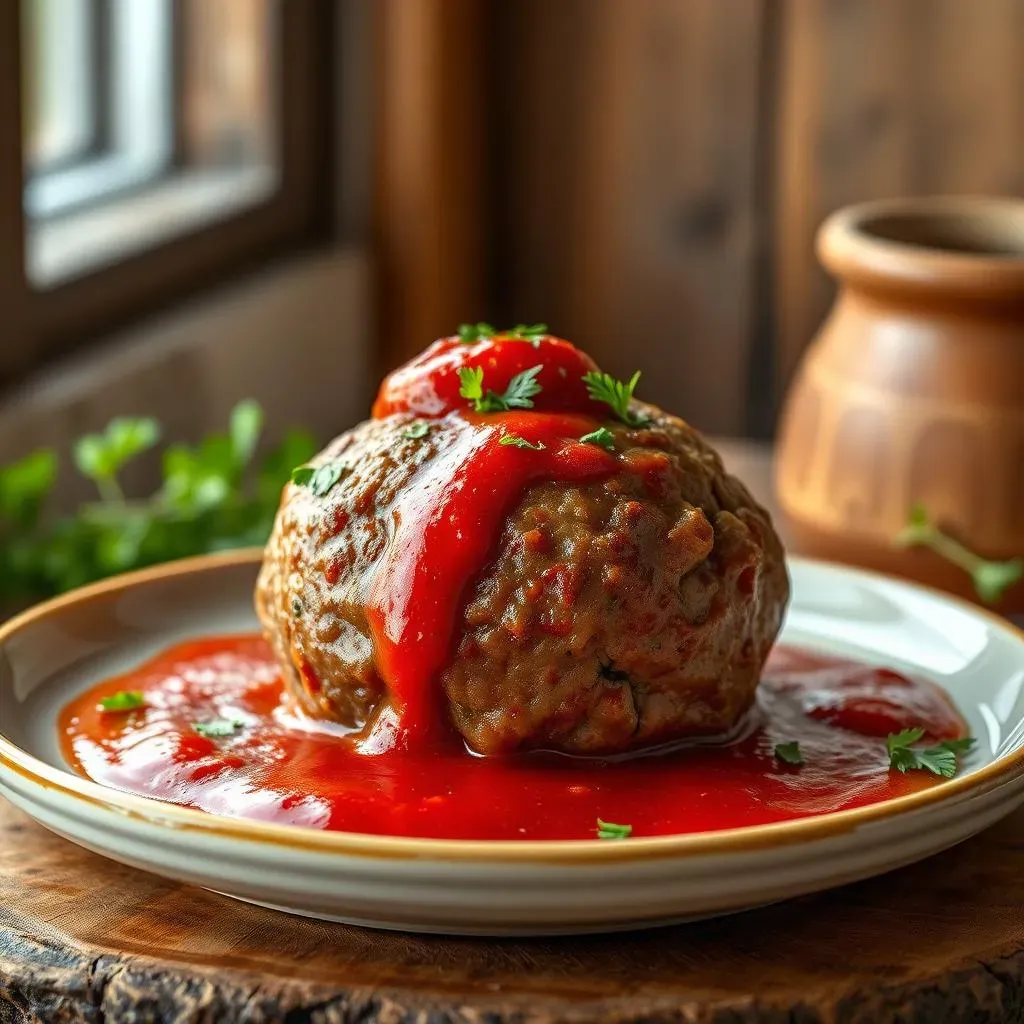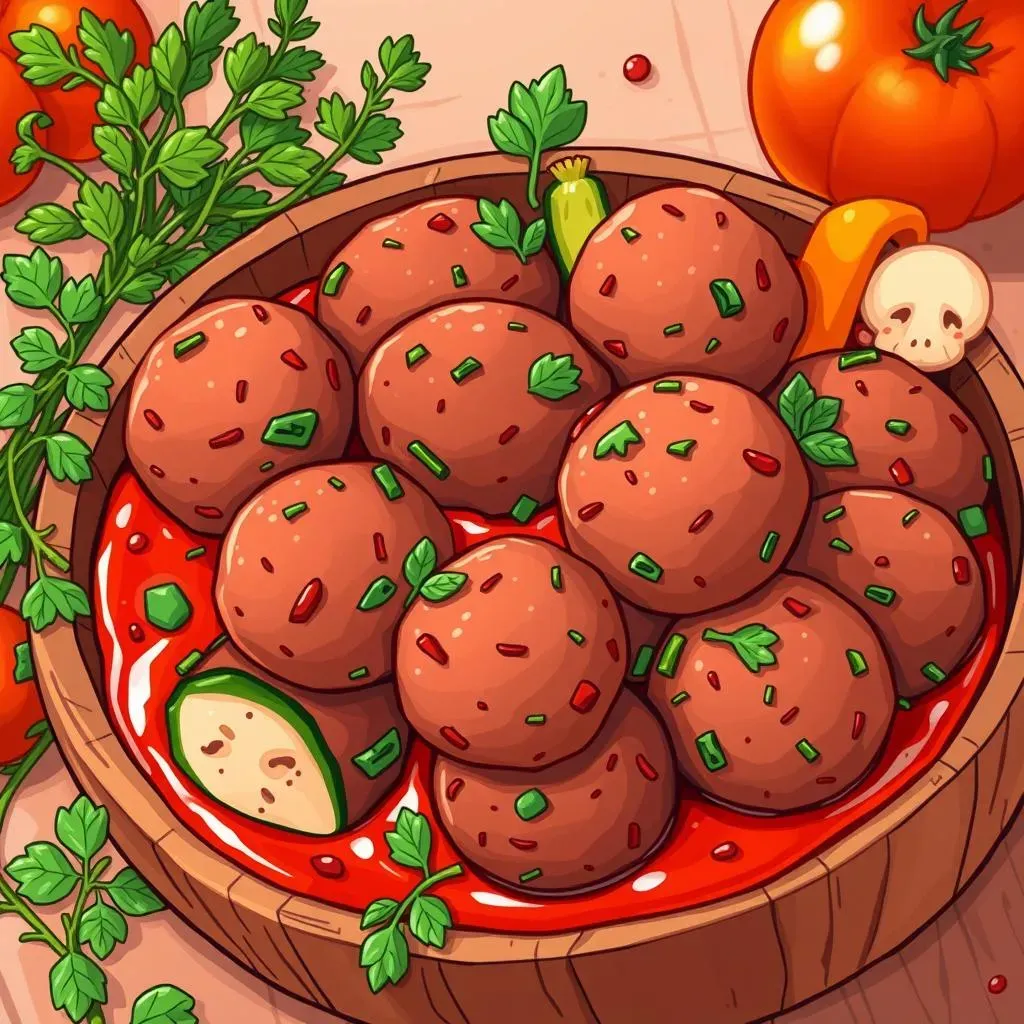Are you looking for a tasty and nutritious way to feed your little one? Well, you've come to the right place! This article is all about the wonderful world of beef meatballs, specifically designed for toddlers. We know getting kids to eat can feel like a battle, but meatballs are often a winner, and this beef meatball recipe for toddlers is no exception. They're soft, easy to chew, and packed with goodness. We'll explore why meatballs are such a great food for growing toddlers, plus provide a foolproof recipe for making them at home. We will also discuss different ways to serve them and how to store them for later. Get ready to become a meatball master, and make mealtime a little less stressful and a lot more fun. We will also cover recipe variations and address common questions, so you'll have all the tools you need to make the perfect meatballs for your tot.
Why Meatballs are Great for Toddlers

Why Meatballs are Great for Toddlers
Nutrient Powerhouses
Let's face it, toddlers can be picky eaters. But meatballs? They're often a hit! And it's not just because they're fun to eat. Meatballs, especially ones made with beef, are packed with essential nutrients that growing bodies need. We're talking about iron, which is crucial for brain development and preventing anemia. They also offer a good dose of protein, vital for building strong muscles and keeping those little energy levels up. Plus, you can sneak in some finely chopped veggies, boosting their vitamin intake without them even noticing!
I know, I know, getting them to eat anything green can feel like a victory. But with meatballs, it's like a secret weapon. You can finely grate carrots, zucchini, or even spinach, and they practically disappear into the mix. It’s like a magic trick, but instead of pulling a rabbit out of a hat, you're pulling out extra vitamins and minerals into your toddler's tummy!
Perfect for Little Hands and Mouths
Another reason I'm a big fan of meatballs for toddlers? Their size and texture are just perfect for little ones still learning how to manage different foods. They’re soft and easy to chew, which is great news for babies transitioning to solids and toddlers who might still be working on their chewing skills. The round shape makes them easy for those tiny hands to grab and self-feed, promoting independence at mealtime. And, let's be honest, anything that encourages self-feeding is a win for busy parents!
They are also versatile, you can mash them up for younger babies just starting out with solids, or serve them whole for toddlers who are more confident with their chewing. You can also cut them up into smaller pieces if you want to be extra safe, making them adaptable to different stages of development. It's like they're designed specifically for toddlers and their unique needs.
Versatility and Fun
Beyond all the nutritional benefits and perfect sizing, meatballs are just plain fun! You can serve them in so many different ways – with pasta, in a mini-sub, with a side of mashed potatoes, or even just on their own as a finger food. The options are endless, which means you can keep things interesting for your toddler and avoid mealtime monotony. You can make it a game, too, by letting them help you roll the meatballs or choose a dipping sauce. It’s all about making mealtime an enjoyable experience for everyone involved.
Plus, they're great for batch cooking. You can make a big batch of meatballs and freeze them, saving you time and effort on busy weeknights. It’s always a lifesaver to have some healthy, homemade food ready to go in the freezer. So, if you're looking for a toddler-friendly food that's nutritious, easy to eat, and endlessly versatile, meatballs are definitely the way to go! It’s a win-win situation for both you and your little one.
Making the Perfect Beef Meatball for Your Little One

Making the Perfect Beef Meatball for Your Little One
Okay, so you're ready to make some amazing meatballs? Awesome! Let's talk about getting them just right for your toddler. The key here is to keep things simple and focus on a few important elements. First, you'll want to choose your beef wisely. Lean ground beef is a great option, as it's not too fatty and is easier for little tummies to digest. Then, it's all about the binders – things that hold the meatball together. We're not going for a hockey puck here. Instead, we want a nice, soft texture that's easy for toddlers to handle. Breadcrumbs, a little milk, and an egg are your friends here. And don't forget to add some flavor! A little bit of onion and some mild spices can make a big difference. But the real trick is to keep the spices mild, remember, we are not trying to make them taste like a spicy dish.
Before you start mixing, make sure your veggies are finely chopped or grated. This is crucial. You don't want big chunks of onion or carrot that your toddler might refuse to eat. It’s all about sneaking those veggies in without them noticing. I always use a food processor for this, it makes life so much easier. Also, don't overwork the meatball mixture. Overmixing can make the meatballs tough, and we want them soft and tender. Just mix everything until it's combined, and then get ready to roll! Using a small spoon can help get them to a good size, and remember that they will shrink a little when cooking. Just make sure you have a baking tray ready, or if you want, you can simmer them in sauce, both ways work great!
Here's a quick guide to the key ingredients and their roles:
Ingredient | Role |
|---|---|
Lean Ground Beef | Main source of protein and iron. |
Breadcrumbs | Helps bind the ingredients and adds softness. |
Milk | Adds moisture and helps create a tender texture. |
Egg | Acts as a binder to hold the meatball together. |
Onion (finely chopped) | Adds flavor and nutrients. |
Mild Spices | Enhances the flavor profile without being overwhelming. |
Finely Grated Veggies | Boosts vitamin intake. |
“The secret to making toddler-friendly meatballs is all about texture and taste. Keep it soft, keep it mild, and they’ll gobble them up!”
Serving and Storing Your Toddler's Beef Meatballs

Serving and Storing Your Toddler's Beef Meatballs
Serving Suggestions for Happy Toddlers
Alright, you've made a batch of amazing beef meatballs, now what? Serving them up in a way that your toddler will actually enjoy is key. I've found that presentation can make all the difference with little ones. First off, think about size. For younger toddlers or babies starting solids, mash or dice the meatballs into small, manageable pieces. This makes it easier for them to handle and reduces any risk of choking. As they get older and more confident, you can offer them whole meatballs. You can serve them with a variety of options. Try pairing them with a simple tomato sauce and some whole wheat pasta, or alongside a serving of mashed sweet potatoes. The options are really endless. Remember, you can also just serve them as finger foods on their own. Remember to always offer a variety of foods to your toddler, not just meatballs.
Also, remember to keep things fun and interactive. Let your toddler dip their meatballs in a little bit of plain yogurt or a mild veggie puree. It’s all about experimenting and finding what they enjoy. It is ok to be creative and think outside of the box, you can also cut them up into fun shapes if you're feeling extra creative. If you have some extra time, try making a mini meatball sub. Little things like this can make mealtime more engaging for your toddler. And, if all else fails, remember that sometimes toddlers just want to eat with their hands. Embrace the mess, and try to make it an enjoyable experience for both of you.
Storage Tips for Busy Parents
Now, let's talk about storing these little wonders. The great thing about meatballs is that they are perfect for batch cooking and meal prepping. Once they are cooked, you can store them in the fridge for up to three to four days. Make sure you put them in an airtight container to keep them fresh and prevent them from drying out. If you want to store them for longer, you can freeze them for up to three months. I personally like to freeze them in individual portions, this makes it easy to pull out just the right amount for a quick meal. You can freeze them on a baking sheet first, before transfer them to a freezer bag, this will prevent them from sticking together.
When you're ready to use the frozen meatballs, you can either thaw them in the fridge overnight or reheat them directly from frozen. You can reheat them in the microwave, oven, or in a saucepan with a little bit of sauce. Just make sure they are heated through completely before serving them to your toddler. Having a stash of homemade meatballs in the freezer is a real lifesaver. It’s like having a secret weapon against those last-minute mealtime emergencies. With a bit of planning, you can always have a healthy and delicious meal ready for your little one without having to rely on processed foods or takeout. It is also a great way to make sure that your toddler is eating a balanced meal even during your busiest days.
Here's a quick guide to storing your meatballs:
- Refrigerator: Store cooked meatballs in an airtight container for up to 3-4 days.
- Freezer: Freeze cooked meatballs for up to 3 months. Freeze them individually on a baking sheet before transferring to a freezer bag to prevent sticking.
- Reheating: Thaw in the fridge overnight or reheat directly from frozen in the microwave, oven, or saucepan. Ensure they are heated through completely before serving.
"Batch cooking and freezing meatballs is a game-changer for busy parents. It's like having a nutritious meal on standby!"
Beef Meatball Recipe Variations and Tips

Beef Meatball Recipe Variations and Tips
Switching Up the Meat
Okay, so you've nailed the basic beef meatball, that's fantastic! But what if you want to mix things up a little? Well, the great news is that meatballs are super versatile, and you can easily swap out the ground beef for other types of meat. Ground turkey is a fantastic option, as it's leaner and has a milder flavor, which some toddlers might prefer. You can also try using ground chicken or even a mix of beef and pork for a slightly different taste. Just make sure you choose a lean option to avoid making them too greasy. The key is to experiment and see what your little one likes best. I've found that toddlers' tastes can change so quickly, having a few options is always helpful.
Another thing you can do is add some different types of veggies. While carrots and zucchini are great, don’t be afraid to get creative. Finely chopped bell peppers, mushrooms, or even some sweet potato can be a great addition. Remember to make sure that they are very finely chopped, you don't want big chunks that your toddler might not like. If you're feeling adventurous, you could even add a pinch of herbs, like oregano or basil, to give them a little extra flavor. Just remember to keep the spices mild. The goal here is to make them nutritious, tasty, and toddler-friendly. It's all about finding that perfect balance!
Tips for Success
Now, let's talk about some tips to make sure your meatballs turn out perfect every time. First off, remember that the key to a soft meatball is to not overwork the mixture. Mix everything just until it's combined, and then stop. Overmixing can make them tough, and we want them nice and tender. Also, make sure your breadcrumbs are fresh. Stale breadcrumbs can make the meatballs dry, and you want them to be moist and delicious. If you don't have breadcrumbs, you can use some rolled oats instead, it works just as well. Another great tip is to chill the meatball mixture for about 30 minutes before you start rolling them. This makes them easier to handle and prevents them from sticking to your hands.
When cooking, you can either bake them or simmer them in sauce. Both ways work great, so it's really up to you. If you are baking, make sure to preheat the oven and lightly grease the baking sheet, this will prevent the meatballs from sticking. If you are simmering them in sauce, make sure the sauce is not too hot, you don't want to overcook them. And, finally, don't be afraid to experiment with different flavors and ingredients. The best way to find out what your toddler likes is to try new things. Remember, cooking should be fun and stress-free, so don't worry if things don't always turn out perfectly. The most important thing is that you are making a healthy and nutritious meal for your little one.
Here are some quick tips for perfect toddler meatballs:
- Don't overmix: Mix ingredients until just combined to keep meatballs tender.
- Fresh Breadcrumbs: Use fresh breadcrumbs for moist meatballs.
- Chill the mixture: Chill for 30 minutes before rolling for easier handling.
- Bake or Simmer: Choose your preferred cooking method - both work well.
- Experiment: Don't be afraid to try different flavors and ingredients.
“Variety is the spice of life, and the same goes for toddler meals. Don't be afraid to mix it up and see what your little one enjoys!”
Frequently Asked Questions About Toddler Meatballs

Frequently Asked Questions About Toddler Meatballs
Alright, let's tackle some of the most common questions that pop up when making meatballs for toddlers. I know, you might be wondering, "Are meatballs really safe for my little one?" or "Can I freeze these things?". Don't worry, I've been there, and I've got the answers for you. One of the biggest concerns parents have is about choking hazards. It’s a valid worry, especially with toddlers just starting to explore solid foods. So, let's put those fears to rest. When you're serving meatballs, make sure you cut them into small, manageable pieces. If you are starting with a baby, you can mash them up. And always, always supervise your little one while they are eating. Another common question is about allergies. If your toddler has any known allergies, like to eggs or dairy, you can always make some changes to the recipe. There are plenty of ways to make these meatballs without eggs or dairy, so don't worry. It's all about making them work for your family’s needs.
Another thing parents often ask is, "How do I get my picky eater to actually try these?" Well, that's the million-dollar question, isn't it? The thing is, every kid is different, so what works for one might not work for another. But, I've found that involving them in the cooking process can make a big difference. Let them help you roll the meatballs or choose a dipping sauce. It makes them feel like they have some ownership, and they might be more likely to try them. Also, don't give up if they don't like them the first time. It can take multiple tries before a toddler accepts a new food. Just keep offering them, and don't make a big deal about it if they refuse. And last, but not least, "Can I freeze these meatballs?" Absolutely! Meatballs are perfect for freezing. Make a big batch and freeze them in individual portions for a quick meal whenever you need it. It's a lifesaver for busy parents!
Here are some of the most common questions about toddler meatballs:
- Are meatballs safe for my toddler? Yes, if cut into small pieces or mashed for younger toddlers. Always supervise during mealtime.
- What if my toddler has allergies? You can modify the recipe to be egg-free, dairy-free, or gluten-free.
- How do I get my picky eater to try them? Involve them in the cooking process, offer them multiple times, and don't make a big deal about it if they refuse.
- Can I freeze meatballs? Yes, they freeze well for up to three months. Freeze individually on a baking sheet before transferring to a freezer bag.
- What if my toddler has a reaction? If you see any reaction, stop feeding the meatballs and consult with your pediatrician.
“Don't stress over picky eaters. Just keep offering healthy options and remember that it’s a journey, not a destination.”